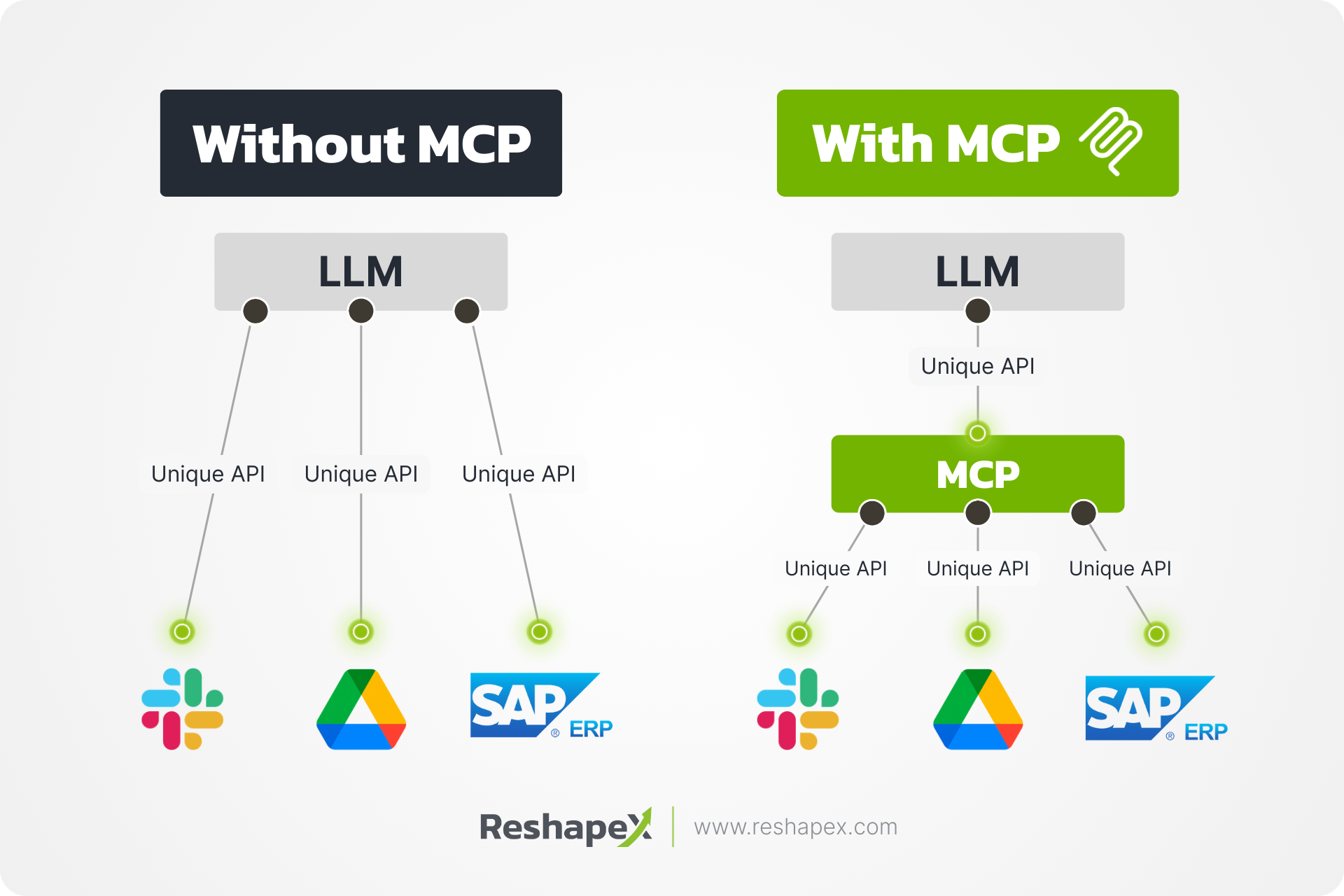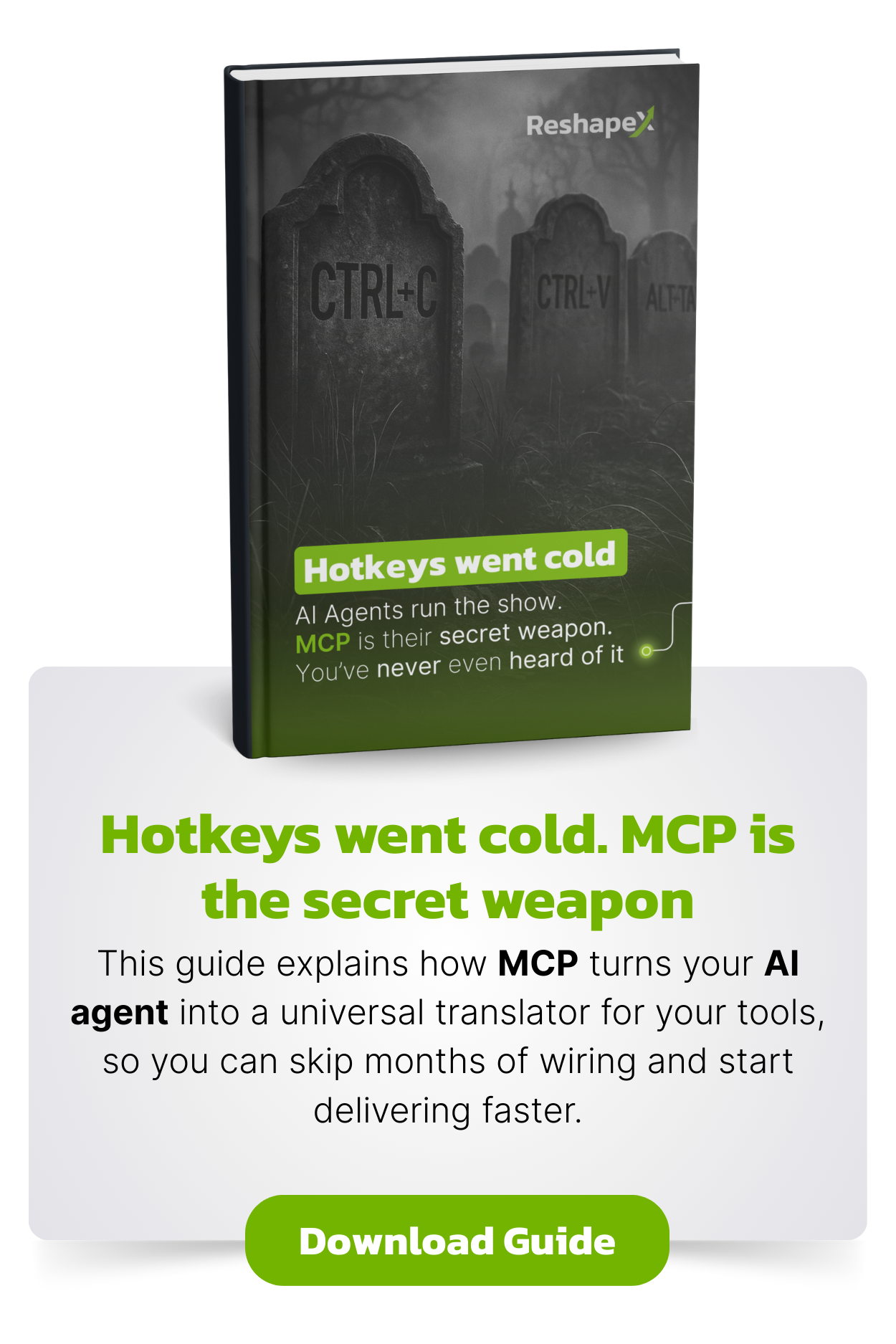MCP, or Model Context Protocol, was invented by Anthropic and is now widely used to connect Large Language Models (LLMs) with external tools in a structured, dynamic, and standardized way. Recently, major players like OpenAI, Google, and Microsoft have announced support for MCP, underscoring its significance as a foundational element for scalable AI integration.
MCP Beyond Robotics
In software engineering, MCP allows LLMs to connect with APIs, databases, and cloud-based platforms. It enables AI to:
- Write and update code based on specific application contexts.
- Query databases or initiate business processes.
- Automate actions across multiple IT systems, from sending emails to managing infrastructure. MCP essentially acts as a dynamic interface layer between context-aware AI agents and the tools they need to work with, greatly reducing manual coding and scripting.

What If We Bring MCP to Robotics?
The same power that MCP brings to IT tools: dynamic context, flexible integration, and real-time adaptability can transform the robotics world. Instead of rigid, hardcoded integration between robots and enterprise systems, MCP enables a seamless bridge where robots can dynamically understand, adapt to, and communicate with IT systems. Imagine:
- Robots that update inventory systems automatically after completing tasks.
- AMRs that send maintenance alerts or schedule service based on real-time operational status.
- Robotic arms that adjust to new workcell configurations without reprogramming.
Where OT-IT Integrations Could Leverage MCP
Traditionally, integrating robots into enterprise IT systems meant custom-coded, rigid, and costly integration processes. Tasks such as sending an SMS notification upon the completion of a robot’s task or automatically opening a service ticket when an Autonomous Mobile Robot (AMR) stalls required significant development effort. MCP simplifies these processes by standardizing communication protocols, enabling:
- Quick integration with enterprise IT systems.
- Dynamic responses to changing operational conditions.
- Enhanced collaboration across diverse robotic and IT platforms.
Real-World Applications of MCP in Robotics
Imagine a scenario:
Without MCP:
- A robot completes its task but requires custom software integration to trigger a notification or action in the company’s IT infrastructure.
- Changes or additions in the robotic environment lead to downtime and extensive reprogramming.
With MCP:
- When a robot finishes stacking pallets, MCP can automatically trigger an SMS notification to warehouse managers.
- If an AMR is stalled or detects an obstacle, MCP can seamlessly create a maintenance ticket in the facility management system.
MCP and Digital Twins: Enhancing Operational Awareness
Digital twins are powerful for simulating and planning, but MCP enriches these models by translating simulated scenarios directly into actionable, IT-compatible commands and alerts. This integration ensures that simulations don’t just remain theoretical but can actively inform and automate responses in real-world scenarios.
MCP in Multi-Agent Robotics
Robotics increasingly relies on collaborative, multi-agent scenarios, such as:
- AMRs coordinating deliveries.
- Robotic arms working synchronously.
- Vision systems integrated with quality control mechanisms. MCP provides a unified protocol enabling these systems to share real-time context and coordinate effectively, significantly enhancing operational efficiency and flexibility.
Standardizing Integration Across Platforms
MCP encourages standardization similar to previous successful protocols like OPC-UA and ROS, moving away from proprietary silos toward a collaborative and scalable integration model. This approach empowers vendors, integrators, and end-users by drastically reducing integration complexity and deployment times.
Limitations and Risks of MCP
While MCP holds great promise, there are challenges and risks that must be addressed for successful adoption:
Security Vulnerabilities:
Open architecture can introduce tool poisoning, prompt injection attacks, and potential credential theft if MCP servers aren’t properly secured.
Implementation Complexity:
Effective use of MCP requires expertise in AI infrastructure and secure configuration of MCP servers and clients.
Potential for Misuse:
Without proper access controls and monitoring, MCP could inadvertently grant AI systems access to sensitive data or tools, risking unintended consequences.
Non-Deterministic and Non-Real-Time Behavior:
LLMs and AI agents, which MCP relies on, can exhibit non-deterministic behavior and lack real-time guarantees. This makes MCP unsuitable for replacing existing OT protocols where safety-critical, deterministic communication is essential.
Complementary to OT Protocols:
MCP is best used as a layer for connecting IT systems and enabling context-aware coordination in non-safety-critical environments, rather than replacing robust industrial protocols that handle real-time, deterministic operations.

The Future of MCP in Robotics and Beyond
The adoption of MCP by major AI and tech companies signifies its potential to become the de facto standard for context-based interaction. In robotics, this could translate into:
- Seamless collaboration between IT and OT systems.
- Reduced deployment times and increased system reliability.
- Expanded use cases in adaptive manufacturing, logistics, and service robotics.
Beyond robotics, MCP's potential to unify IT toolchains and dynamic AI-driven processes could unlock:
- Real-time orchestration of enterprise workflows.
- Simplified integration for SaaS platforms and legacy systems.
- Context-aware digital agents capable of automating complex, multi-step processes.
Conclusion: MCP as a Catalyst for the Next Generation of Automation
MCP is not merely an incremental technology upgrade, it represents a significant shift in integrating robotics, IT systems, and AI. As adoption continues and standards mature, MCP will drive scalable, intelligent, and seamlessly interconnected industrial and IT automation, redefining how we design, deploy, and operate across the enterprise landscape.
ReshapeX: Driving the Future of AI Integration
At Reshape Automation, we have created ReshapeX, a unique platform to program AI workflows. We leverage MCP and are excited to bring our partners into this revolution, making their systems more connected without compromising performance or safety.







.png)